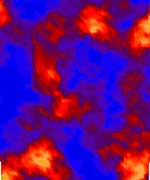Cassini-Huygens supplied new evidence about why Titan has an atmosphere, making it unique among all solar system moons, a University of Arizona planetary scientist says.
Scientists can infer from Cassini-Huygens results that Titan has ammonia, said Jonathan I. Lunine, an interdisciplinary scientist for the European Space Agency’s Huygens probe that landed on Titan last month.
“I think what’s clear from the data is that Titan has accreted or acquired significant amounts of ammonia, as well as water,” Lunine said. “If ammonia is present, it may be responsible for resurfacing significant parts of Titan.”
He predicts that Cassini instruments will find that Titan has a liquid ammonia-and-water layer beneath its hard, water-ice surface. Cassini will see — Cassini radar has likely already seen — places where liquid ammonia-and-water slurry erupted from extremely cold volcanoes and flowed across Titan’s landscape. Ammonia in the thick mixture released in this way, called “cryovolcanism,” could be the source of molecular nitrogen, the major gas in Titan’s atmosphere.
Lunine and five other Cassini scientists reported on the latest results from the Cassini-Huygens mission at the American Association for the Advancement of Science meeting in Washington, D.C. today (Feb. 19).
Cassini radar imaged a feature that resembles a basaltic flow on Earth when it made its first close pass by Titan in October 2004. Scientists believe that Titan has a rock core, surrounded by an overlying layer of rock-hard water ice. Ammonia in Titan’s volcanic fluid would lower the freezing point of water, lower the fluid’s density so it would be about as buoyant as water ice, and increase viscosity to about that of basalt, Lunine said. “The feature seen in the radar data suggests ammonia is at work on Titan in cryovolcanism.”
Both Cassini’s Ion Neutral Mass Spectrometer and Huygen’s Gas Chromatograph Mass Spectrometer (GCMS) sampled Titan’s atmosphere, covering the uppermost atmosphere down to the surface.
But neither detected the non-radiogenic form of argon, said Tobias Owen of the University of Hawaii, a Cassini interdisciplinary scientist and member of the GCMS science team. That suggests that the building blocks, or “planetesimals,” that formed Titan contained nitrogen mostly in the form of ammonia.
Titan’s eccentric, rather than circular, orbit can be explained by the moon’s subsurface liquid layer, Lunine said. Gabriel Tobie of the University of Nantes (France), Lunine and others will publish an article about it in a forthcoming issue of Icarus.
“One thing that Titan could not have done during its history is to have a liquid layer that then froze over, because during the freezing process, Titan’s rotation rate would have gone way, way up,” Lunine said. “So either Titan has never had a liquid layer in its interior — which is very hard to countenance, even for a pure water-ice object, because the energy of accretion would have melted water — or that liquid layer has been maintained up until today. And the only way you maintain that liquid layer to the present is have ammonia in the mixture.”
Cassini radar spotted a crater the size of Iowa when it flew within 1,577 kilometers (980 miles) of Titan on Tuesday, Feb. 15. “It’s exciting to see a remnant of an impact basin,” said Lunine, who discussed more new radar results that NASA released at an AAAS news briefing today. “Big impact craters on Earth are nice places for getting hydrothermal systems. Maybe Titan has a kind of analogous ‘methanothermal’ system,” he said.
Radar results that show few impact craters is consistent with very young surfaces. “That means Titan’s craters are either being obliterated by resurfacing, or they are being buried by organics,” Lunine said. “We don’t know which case it is.” Researchers believe that hydrocarbon particles that fill Titan’s hazy atmosphere fall from the sky and blanket the ground below. If this has occurred throughout Titan’s history, Titan would have “the biggest hydrocarbon reservoir of any of the solid bodies in the solar system,” Lunine noted.
In addition to the question about why Titan has an atmosphere, there are two other great questions about Saturn’s giant moon, Lunine added.
A second question is how much methane has been destroyed throughout Titan’s history, and where all that methane comes from. Earth-based and space-based observers have long known that Titan’s atmosphere contains methane, ethane, acetylene and many other hydrocarbon compounds. Sunlight irreversibly destroys methane in Titan’s upper atmosphere because the released hydrogen escapes Titan’s weak gravity, leaving ethane and other hydrocarbons behind.
When the Huygens probe warmed Titan’s damp surface where it landed, its instruments inhaled whiffs of methane. That is solid evidence that methane rain forms the complex network of narrow drainage channels running from brighter highlands to lower, flatter dark areas. Pictures from the UA-led Descent Imager-Spectral Radiometer experiment document Titan’s fluvial features.
The third question — one that Cassini was not really instrumented to answer — Lunine calls the “astrobiological” question. It is, given that liquid methane and its organic products rain down from Titan’s stratosphere, how far has organic chemistry progressed on Titan’s surface? The question is, Lunine said, “To what extent is any possible advanced chemistry at Titan’s surface at all relevant to prebiotic chemistry that presumably occurred on Earth prior to the time life began?”
The Cassini-Huygens mission is a collaboration between NASA, ESA and ASI, the Italian Space Agency. The Jet Propulsion Laboratory (JPL), a division of the California Institute of Technology in Pasadena, is managing the mission for NASA’s Science Mission Directorate, Washington, D.C. JPL designed, developed and assembled the Cassini oribter while ESA operated the Huygens probe.
Original Source: University of Arizona News Release

